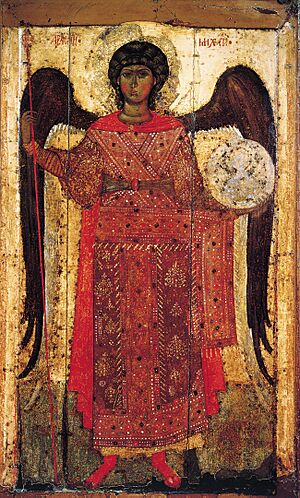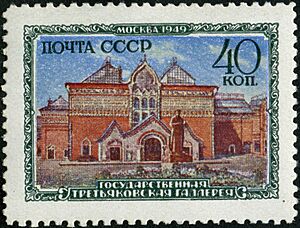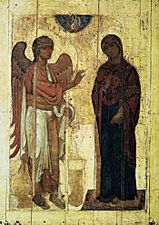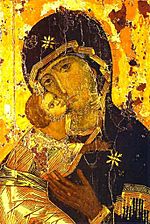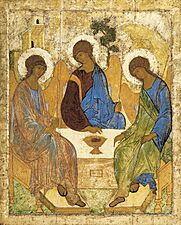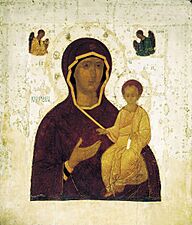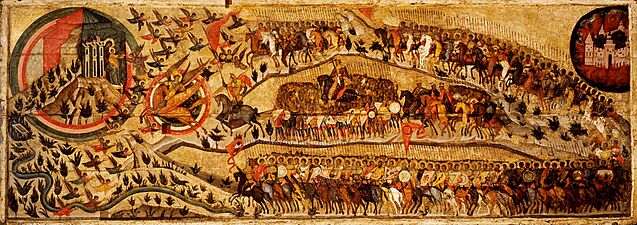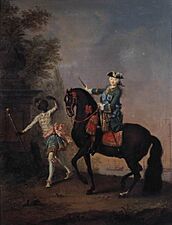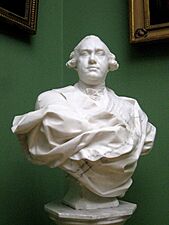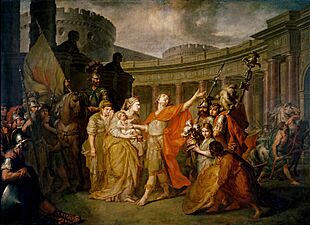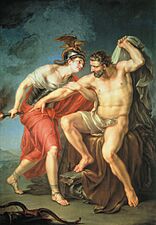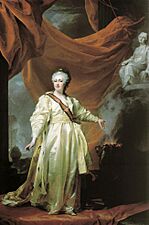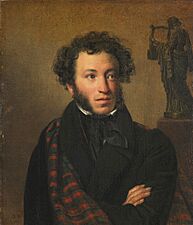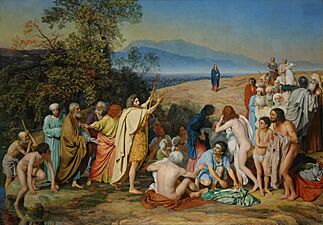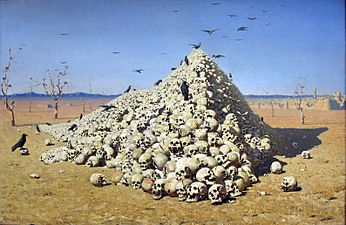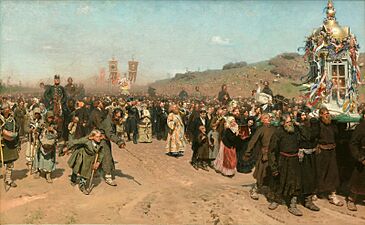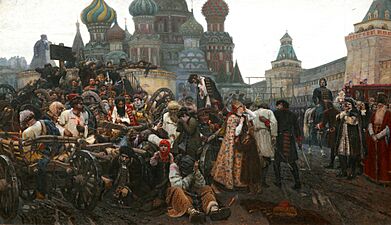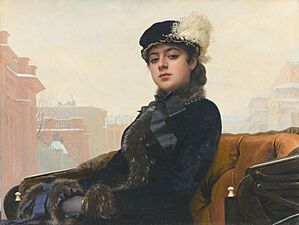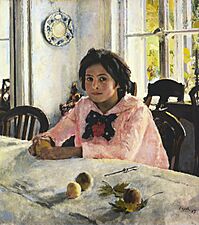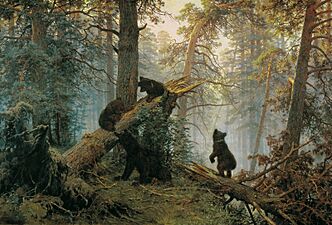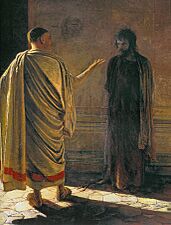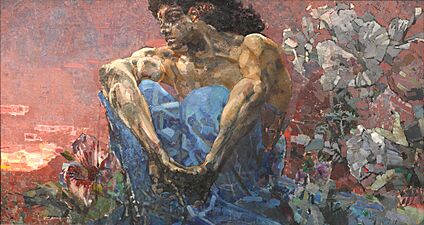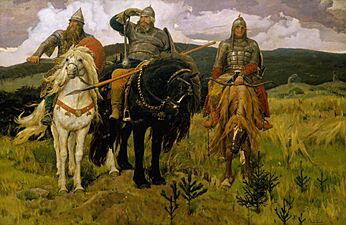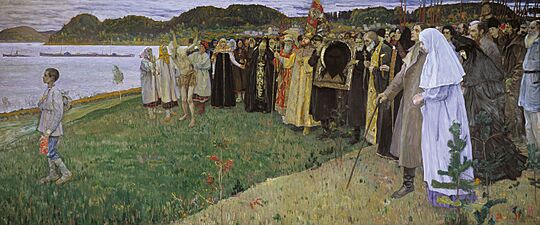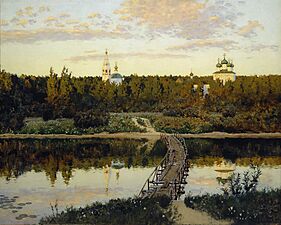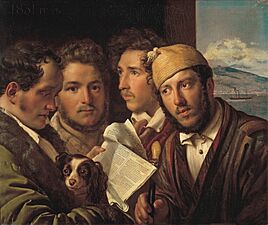Tretyakov Gallery facts for kids
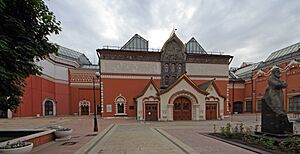
Lavrushinsky Lane
|
|
| Established | 1856 |
|---|---|
| Location | Moscow, Russia |
| Type | Art museum |
| Visitors | 894,374 (2020)
|
The State Tretyakov Gallery is a famous art gallery in Moscow, Russia. Many people consider it the best place in the world to see Russian fine art.
The gallery started in 1856. A rich merchant from Moscow, Pavel Mikhailovich Tretyakov, began buying art from Russian artists. He wanted to create a special collection that would one day become a museum for the whole country. In 1892, Tretyakov gave his amazing collection to the Russian nation. It had about 2,000 artworks, including paintings, drawings, and sculptures. In 2020, almost 900,000 people visited the museum. It was the 13th most visited art museum in the world that year.
The main building of the gallery looks like something from a Russian fairy-tale. The artist Viktor Vasnetsov designed its unique look. It was built between 1902 and 1904, south of the Moscow Kremlin. Over time, the gallery grew and took over several buildings nearby. This includes the old 17th-century church of St. Nicholas in Tolmachi. Today, the collection has more than 130,000 items. These range from very old icons like the Theotokos of Vladimir to modern masterpieces. Some famous modern works include Composition VII by Wassily Kandinsky and the Black Square by Kazimir Malevich.
In May 2012, the Tretyakov Gallery hosted the FIDE World Chess Championship. Organizers hoped this event would promote both chess and art. In May 2023, the museum faced a challenge. It was asked to give one of its most famous icons, Andrei Rublev's Trinity, to the Russian Orthodox Church. The museum did not want to give it up. However, in June 2023, the icon was moved to Moscow's main cathedral.
The State Tretyakov Gallery also manages other art spaces. This includes a gallery of modern art in Moscow. There are also smaller galleries in other parts of Russia. These are in Kaliningrad in the west and Vladivostok in the far east.
Contents
History of the Gallery

Pavel Tretyakov began collecting art in the mid-1850s. The Tretyakov Gallery officially started in 1856. That year, Tretyakov bought two paintings by Russian artists. These were Temptation by Nikolay Shilder and Skirmish with Finnish Smugglers by Vasily Khudyakov. He had also bought some drawings and paintings by Dutch Old Masters earlier.
In 1867, the Moscow City Gallery of Pavel and Sergei Tretyakov opened. It had many paintings, sculptures, and drawings by Russian artists. There were also some works by foreign artists.
In August 1892, Tretyakov gave his entire art gallery to the city of Moscow. At that time, the collection had over 1,200 Russian paintings. It also included graphic works, European paintings, sculptures, and icons. The museum officially opened to the public on August 15, 1893. It was called the Moscow City Gallery of Pavel and Sergei Tretyakov.
The gallery was located in a large house that the Tretyakov family bought in 1851. As Pavel's art collection grew, the house became full of art. More parts had to be added to the building to hold and show all the artworks. Additions were made several times between 1873 and 1904. The famous fairy-tale style front of the building was designed by artist Viktor Vasnetsov.
In 1913, Igor Grabar was chosen to be in charge of the Tretyakov Gallery.
On June 3, 1918, the Tretyakov Gallery became owned by the Russian government. It was then named the State Tretyakov Gallery. Igor Grabar became its director again. He helped create the State Museum Fund. This fund was important for adding new artworks to the gallery's collection.
In 1926, Alexey Shchusev, a famous architect, became the director. The next year, the gallery got the house next door. This building was used for offices, a library, and storage. Later, a new administrative building was built there.
In 1928, the gallery had major updates. It got new heating and ventilation systems. In 1929, electricity was installed.
The Church of St. Nicholas in Tolmachi was closed in 1929. In 1932, the church building was given to the gallery. It was used to store paintings and sculptures. Later, the church was connected to the main exhibition halls. A special top floor was built to display a huge painting by Alexander Andreyevich Ivanov, The Appearance of Christ Before the People. This helped visitors move smoothly through the museum.
In 1936, a new two-story building was added on the north side. It is known as the Schusevsky building. These halls were first used for special exhibitions. Since 1940, they have been part of the main tour route.
When World War II (called the Great War in Russia) began, the gallery staff quickly packed up the artworks. They rolled paintings onto wooden poles and put them in special boxes. In the summer of 1941, 17 train cars carried the collection to Novosibirsk for safety. The gallery reopened in Moscow on May 17, 1945, after the war ended.
In 1956, the Alexander Ivanov Hall was finished. This was to celebrate the gallery's 100th anniversary.
From 1980 to 1992, Y. K. Korolev was the director. He worked hard to make the gallery bigger because more and more people were visiting. In 1983, construction began to expand the gallery. In 1985, a new building called the Depository was opened. It was used to store artworks and for art restoration. In 1986, major renovations started on the main Tretyakov Gallery building. Many architects worked on this project. In 1989, a new building was added on the south side. It has a conference hall, a computer center, and rooms for children's art classes. This building is called the "Corps of Engineers."
From 1986 to 1995, the main Tretyakov Gallery building was closed for these big renovations. During this time, the only part of the museum open was a building on Krymsky Val. This building had joined the Tretyakov Gallery in 1985.
Other Tretyakov Gallery Locations
The Tretyakov Gallery organization manages several other sites. The most important are a second large gallery in Moscow and two galleries far away.
Gallery of Modern Art
In 1985, the Tretyakov Gallery joined with a gallery of modern art. This gallery is in the Central House of the Artists. It is a large, modern building in Moscow. Outside this museum, there is a collection of sculptures from the Soviet era. These include famous statues like Iron Felix. There is also the Swords Into Plowshares sculpture, showing a worker turning a sword into a farm tool. Nearby is a very tall statue of Peter the Great, one of the tallest outdoor statues in the world.
Near the modern art gallery, there is a sculpture garden. People call it "the graveyard of fallen monuments." It displays statues from the former Soviet Union that were moved from their original places.
Kaliningrad and Vladivostok
New branches of the Tretyakov Gallery have opened in other parts of Russia. These are in Kaliningrad in the far west and Vladivostok in the far east. These new galleries were built using money from oil and gas sales.
Directors
- Valentin Rodionov (1993-2009)
- Irina Lebedeba (2009-2015)
- Zelfira Tregulova (2015-2023)
- Yelena Pronicheva (since 2023)
Gallery
-
Theotokos of Vladimir (c. 1130)
-
Andrei Rublev, Trinity (1411 or 1423–1425)
-
Ivan Akimov, Hercules Burning Himself on the Pyre in the Presence of His Friend Philoctetes (1782)
-
Dmitry Levitzky, Catherine the Great in a Temple of Justice (1783)
-
Vladimir Borovikovsky, Portrait of Maria Lopukhina (1797)
-
Orest Kiprensky, Portrait of Alexander Pushkin (1823)
-
Karl Bryullov, Horsewoman (1832)
-
Alexander Ivanov, The Appearance of Christ Before the People (1837–1857)
-
Vasily Vereshchagin, The Apotheosis of War (1871)
-
Ivan Kramskoi, Christ in the Desert (1872)
-
Ilya Repin, Religious Procession in Kursk Province (1880–1883)
-
Vasily Surikov, The Morning of the Streltsy Execution (1881)
-
Ivan Kramskoi, Portrait of an Unknown Woman (1883)
-
Ilya Repin, Ivan the Terrible and His Son Ivan (1885)
-
Valentin Serov, Girl with Peaches (1887)
-
Ivan Shishkin and Konstantin Savitsky, Morning in a Pine Forest (1889)
-
Mikhail Vrubel, The Demon Seated (1890)
-
Victor Vasnetsov, Bogatyrs (1898)
-
Mikhail Nesterov, In Rus. The Soul of the People (1916)
-
Isaac Levitan. A Quiet Monastery (1890)
See also
- List of largest art museums
- New Tretyakov Gallery
- Frederic Dubois


